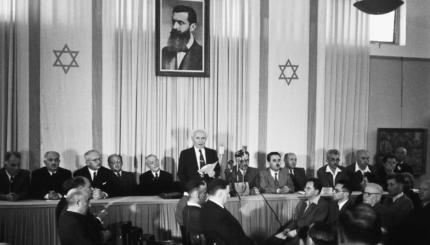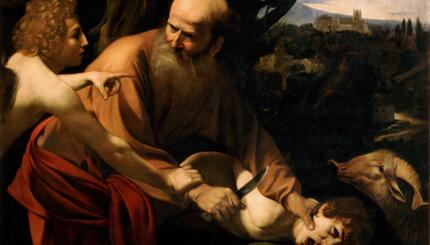The Land of Yehudah (the southern half of the West Bank, also known as Judea) is the cradle of our people’s civilization and is at the heart of our national story. From Jerusalem in the North down through Hebron in the South, this is where we were born and where so much of our history took place. It was here that Abraham walked together with his son on the way to the binding and near sacrifice of the young Isaac. It was here near Migdal Eder that Jacob pitched his tent after the death of his beloved wife Rachel not far from Efrat. Our patriarchs and matriarchs are buried in Ma’arat haMachpala (the Tomb of the Patriarchs) in Hebron. Elazar the Maccabee was killed here under the Greek elephant in an act of mighty heroism for the Jewish people. Near Tekoa, the birthplace of Amos the prophet King Herod built Herodion, a man-made mountain for the site of his palace and grand mausoleum. In Second Temple times the springs of these hills provided water for Jerusalem, carried down to the holy city by amazing aqueducts and subterranean water systems. Yehudah is dotted with caves and tunnels that Bar Kochba’s soldiers carved out of the rock and used for hiding and safety in their battles with the Romans, before their last stand at Beitar leading to defeat and almost 2,000 years of exile from our homeland.
All of this and so much more is found within a geographical area that can be traversed by bus within an hour or two. And that is what my wife and I (and 20 others) did for three days this week. Seventy-two hours of intensive immersion in the story of our people in our land. We walked, and we crawled. We read from the Bible and from Greek and Roman historians. We soaked it up. It was exhilarating.
And what made it all the more meaningful was the fact that it was not about the past, but rather about the continuous lived experience of our people. Long after our defeat at the hands of the Romans, we continued to inhabit this land, against all odds.
When Jewish life in Yehudah was wiped out and forbidden, our forefathers moved a bit south to the Hebron Hills where they inhabited thriving cities like Susia. What a thrill to sit in its impressive synagogue, to walk its streets and to enter its underground caverns. And today just a stone’s throw from ancient Susia sits the modern settlement of Susia, renewing Jewish life in the footsteps of our forefathers.
For the majority of the past 2,000 years, our ancestors maintained a continuous albeit limited presence in Hebron. That presence was interrupted in the year 1936, but by 1969 we had returned, coming back to some of the same houses and synagogues in which we had lived and prayed for hundreds of years. We left the bus and walked the streets of Hebron that are now full of Jewish life. We touched the stones of Ma’arat haMachpala, erected over 2,000 years ago to honor the memory of the founders of the Jewish people laid to rest there after Abraham bought the land for the burial of his wife Sarah.
In 1927 Jews returned home to central Yehudah and founded a settlement they called Migdal Eder, emphasizing the biblical connection through Jacob. We met a 90-year-old woman who was born there. Some of the descendants of those pioneers told us stories of the early days that they had heard from their elders.
Today the memory of Elazar the Maccabee is preserved by the settlement of Elazar erected on the site of the battle in which he was killed. Efrat is not just an obscure place name in the Book of Genesis but rather a thriving city home to thousands of modern-day Jews. The settlement of Karmei Tzur marks the site of another Maccabean battle that preserved the integrity of our people in difficult times. I lived there with my wife and children for three years. Today we live near the site of Migdal Eder, in Alon Shvut, which means the oak of return. The Jewish people have returned home.
Together with the thrill of deepening the connection to my people’s amazing story and our amazing land, I felt a bit of discomfort during these three days. Today I know that our story is not the only story in this land, but no one else in our group — with one exception — seemed to be even vaguely aware of that uncomfortable truth. They were aware that other people have been here and are here now, but for them, the other people are simply background noise. They are illegitimate interlopers. This sense was expressed in tens of different subtle and not so subtle ways.
My pain and sorrow came to a head when we visited an archeological excavation just a minute’s walk from the dining room of Kibbutz Migdal Oz. The guide, a member of the kibbutz, recounted the story of the dig. A group of high school kids from the Bnai Akiva religious youth movement had been recruited for the work. A large imposing structure was slowly unearthed. The building was dated to the third or fouth century. As the days progressed, the excitement mounted. What could such an impressive building have been if not a synagogue?! Here would be further proof of our continuous connection to our land. All anticipated uncovering the niche for the Holy Ark in the wall facing Jerusalem. But the excitement gave way to disappointment and frustration when evidence was uncovered that the building was actually an ancient church.
I understand the disappointment and even identify with it. I suppose that had I been there during the dig I also would have been disappointed. But what followed just broke my heart. The guide told us that when the truth became known, the young excavators were told that this is a teachable moment. As our guide said those words my mind began to race. Within the course of two or three seconds, I was filled with hope as I imagined the young people being told that their frustration ought to be tempered by appreciation, for a house of God has been uncovered. Christians worship the same God that we Jews do, and their divine service is also beloved by the Master of the Universe.
I am so naïve. That is not what the members of the youth movement were told. With great relish, our guide told us that the teachable moment was that we have the opportunity to thank God for the eradication of idolatry! The young people were told that they ought to recite the ancient blessing “Blessed is He who has eradicated idolatry from this place.”
I was crestfallen. Do we teach our young people that Christianity is idolatry? Is that what we believe? That only our religion is legitimate? That only our presence in this land is legitimate? But unfortunately this is indeed what so many in my society believe, and this is indeed what so much of our educational system teaches our young people.
Many things have to change for there to be peace in this land. This is one of them.



